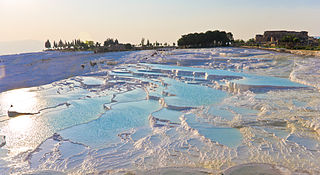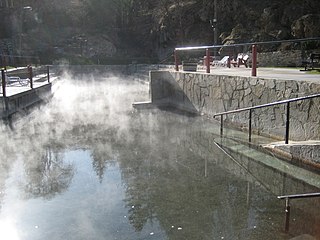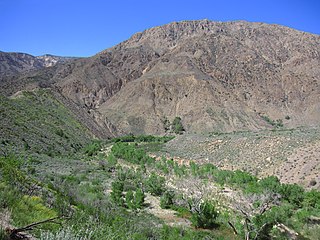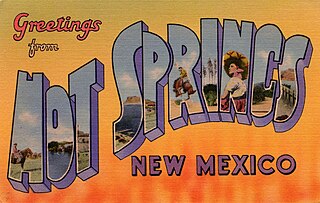
Long Valley Caldera is a depression in eastern California that is adjacent to Mammoth Mountain. The valley is one of the Earth's largest calderas, measuring about 20 mi (32 km) long (east-west), 11 mi (18 km) wide (north-south), and up to 3,000 ft (910 m) deep.

A hot spring, hydrothermal spring, or geothermal spring is a spring produced by the emergence of geothermally heated groundwater onto the surface of the Earth. The groundwater is heated either by shallow bodies of magma or by circulation through faults to hot rock deep in the Earth's crust.

The geothermal areas of Yellowstone include several geyser basins in Yellowstone National Park as well as other geothermal features such as hot springs, mud pots, and fumaroles. The number of thermal features in Yellowstone is estimated at 10,000. A study that was completed in 2011 found that a total of 1,283 geysers have erupted in Yellowstone, 465 of which are active during an average year. These are distributed among nine geyser basins, with a few geysers found in smaller thermal areas throughout the Park. The number of geysers in each geyser basin are as follows: Upper Geyser Basin (410), Midway Geyser Basin (59), Lower Geyser Basin (283), Norris Geyser Basin (193), West Thumb Geyser Basin (84), Gibbon Geyser Basin (24), Lone Star Geyser Basin (21), Shoshone Geyser Basin (107), Heart Lake Geyser Basin (69), other areas (33). Although famous large geysers like Old Faithful are part of the total, most of Yellowstone's geysers are small, erupting to only a foot or two. The hydrothermal system that supplies the geysers with hot water sits within an ancient active caldera. Many of the thermal features in Yellowstone build up sinter, geyserite, or travertine deposits around and within them.

Mammoth Hot Springs is a large complex of hot springs on a hill of travertine in Yellowstone National Park adjacent to Fort Yellowstone and the Mammoth Hot Springs Historic District. It was created over thousands of years as hot water from the spring cooled and deposited calcium carbonate. Because of the huge amount of geothermal vents, travertine flourishes. Although these springs lie outside the caldera boundary, their energy has been attributed to the same magmatic system that fuels other Yellowstone geothermal areas.

Travertine is a form of terrestrial limestone deposited around mineral springs, especially hot springs. It often has a fibrous or concentric appearance and exists in white, tan, cream-colored, and rusty varieties. It is formed by a process of rapid precipitation of calcium carbonate, often at the mouth of a hot spring or in a limestone cave. In the latter, it can form stalactites, stalagmites, and other speleothems. It is frequently used in Italy and elsewhere as a building material. Similar deposits formed from ambient-temperature water are known as tufa.

Pamukkale, meaning "cotton castle" in Turkish, is a natural site in Denizli Province in southwestern Turkey. The area is famous for a carbonate mineral left by the flowing of thermal spring water. It is located in Turkey's Inner Aegean region, in the River Menderes valley, which has a temperate climate for most of the year.

Scovern Hot Springs is a thermal spring system, and former settlement in the Kern River Valley of the Southern Sierra Nevada, in Kern County, California.

Fales Hot Springs is a hot spring in the Sonora Junction area of Mono County, eastern California.

Dirty Socks Hot Spring is a formerly developed hot spring near Death Valley, Inyo County, California, in the United States. A sulfur spring, the naturally occurring unpleasant odor may have been compared to smelly socks. The water is also often discolored with algae growth. Another explanation is that the spring was named from the fact miners washed their dirty socks there. The name may also be rendered as Dirty Sock, singular.

Pagosa hot springs is a hot spring system located in the San Juan Basin of Archuleta County, Colorado. The town of Pagosa Springs claim they are the world's deepest known geothermal hot springs.

Verde Hot Springs is a grouping of thermal mineral springs near the town of Camp Verde in Yavapai County, Arizona. The springs are located at the western bank of the Verde River. There are ruins of a former historical resort at the site and bathhouse.

Mystic Hot Springs, previously known as Monroe Hot Springs and Cooper Hot Springs are located in northeastern Monroe, Utah. The hot mineral water emerges from the spring at 168 °F (76 °C). The water flows into two smaller pools with temperatures between 92 and 102 °F.

Valle Chico Hot Springs is a subaerial thermal spring located at in the Sierra San Pedro Martir mountains of Baja California, Mexico.

Meadow Hot Springs are a system of geothermal springs South of Fillmore, Utah, near the town of Meadow.

Lava Hot Springs are a system of geothermal mineral springs in Bannock County, Idaho, United States, in the area of the city named after them, Lava Hot Springs.

Conundrum Hot Springs is a geothermal spring in a remote section of the Maroon Bells-Snowmass Wilderness area of the White River National Forest in Colorado Rocky Mountains.

Sespe Hot Springs are a system of thermal springs and seeps that form a hot spring creek in the mountains near the Sespe Condor Sanctuary near Ojai, California.
Frenchman's Hot Springs, also known as Frenchman's Bend Hot Springs or Warfield Hot Springs, is a hot spring located along Warm Springs Creek in the Sawtooth National Forest, 11 miles (17.7km) from Ketchum, Idaho. The springs are composed of three wide, shallow pools. The pools are rock-walled, with sand and gravel covered bottoms. The average temperature of the springs varies throughout the year, but most of the time, water enters the springs at around 124°F (51.11°C). The water in the springs is usually clear.

Truth or Consequences Hot Springs is a thermal spring system located in the Hot Springs Artesian Basin area of Truth or Consequences, New Mexico in Sierra County.




















